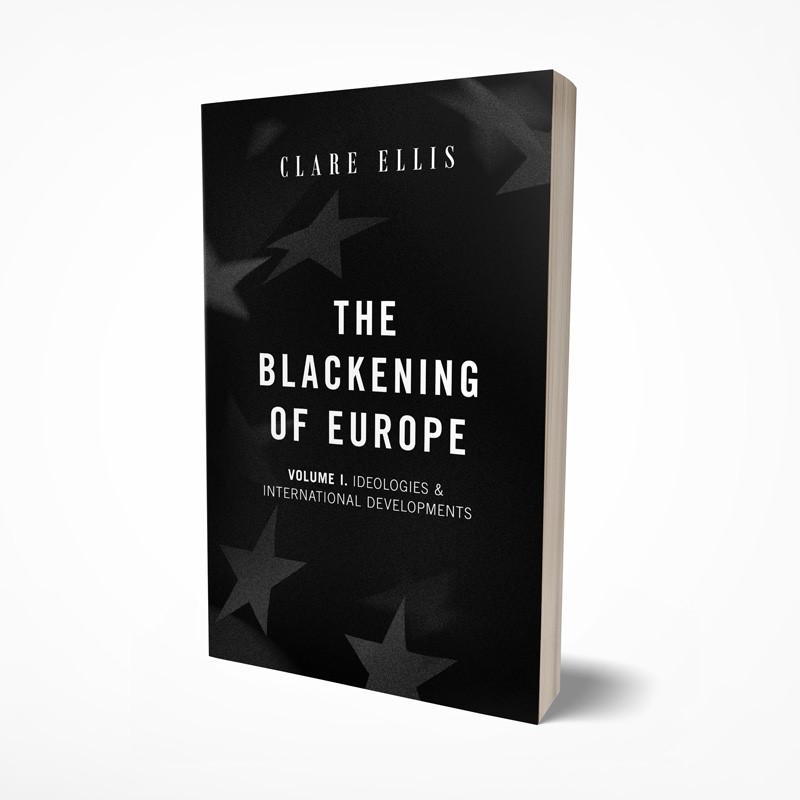
A retrógrada esquerda venceu as guerras culturais nos Estados Unidos. Não há dúvida quanto a isso. Até mesmo a “direita” da mídia, do estabilismo (não confundir com a direita clássica ou tradicionalista) já foi cooptada pela esquerda. Juntas, a esquerda e essa “direita” formam o estabilismo americano de esquerda. Apesar de sua extravasante influência sobre a sociedade e a cultura americanas, o estabilismo não se larga do nacionalismo branco, não o considera cacareco velho como um cilindro fonográfico ou gramofone. Em vez disso, a esquerda conserva o nacionalismo branco enquanto objeto de seu ódio intenso e incendiário.
Mas será que haveria algum mérito na reação do estabilismo ante o nacionalismo branco? Pesquisas focando a atitude racial da população branca dão conta de que os nacionalistas brancos não passam de 5% da população americana; eles podem até ser menos do que 1%. Eles não controlam nenhuma grande corporação ou organização política. Odiados e perseguidos pelo estabelecimento, não surpreende que aos nacionalistas brancos falte maior domínio econômico e político.
Dada a pretensão que tem o estabilismo americano de ignorar os direitos inscritos na Primeira Emenda, os nacionalistas brancos encontram-se sob acosso, tendo contra si uma combinação de medidas legais e econômicas. O tratamento dispensado aos “expressores do ódio” inclui demissão do emprego, bloqueio de acesso à mundirrede, censura à literatura nacionalista branca y otras cositas más. Em contraste, seus oponentes antifas e belemistas [BLM] não sofrem nenhuma restrição da parte do Estado. Eles são bem mais organizados, bem mais patrocinados e bem mais capazes de mobilizar as massas de seus seguidores. O Antifas e o BLM podem despedaçar monumentos históricos dos Estados Unidos, podem transformar seis quadras no centro de Seattle numa “Zona Autônoma” fechada à polícia, na maior impunidade. Será que se dissidentes raciais tivessem tomado o centro de Seattle, fazendo dele um enclave branco fechado à polícia, eles também seriam tratados com luvas de pelica? A hipocrisia dá nojo, mas não surpreende, vinda de onde veio.
Uma ínfima percentagem de brancos chama a si toda a atenção de todo o estabilismo esquerdista. Como é que pode? Quase diariamente a mídia propaga de forma exagerada, ou até mesmo completamente falsa, histórias sobre terrorismo nacionalista branco e repentes de violência branca. A intensa preocupação dos esquerdistas com o nacionalismo branco parece irracional, mas de ponto de vista estratégico faz sentido.
Sabe-se que os dissidentes raciais são as pessoas mais odiadas nos Estados Unidos. Afinal, o nacionalismo branco e o marxismo cultural são ideologias concorrentes; entretanto, no mercado das ideias, as pessoas dão de barato a crença de que nem todas as ideias nascem iguais. O argumento do nacionalismo branco contra a diversidade — ao contrário da alegação do esquerdismo pela diversidade, é inatacável. Desde a ascensão do marxismo cultural na política americana, nunca os esquerdistas foram capazes de elaborar argumento procedente em favor da diversidade.
Os esquerdistas execram e temem a consciência racial branca, por isso é que eles quase nunca debatem com dissidentes raciais na televisão ou na imprensa, senão da forma mais superficial. Num estado de subconsciência, os esquerdistas têm medo do nacionalismo branco, porque acreditam que ele levaria muitos brancos a abandonar o sacralizado projeto multicultural, tão turibulado pela esquerda. Vemos claramente que não se nos depara nenhuma ideologia política racional, senão teocracia secular guiada pela mística de um credo igualitário. Nas “igrejas” do esquerdismo, a fé toma o lugar da razão enquanto árbitro supremo da verdade. Este é o calcanhar de Aquiles do estabilismo esquerdista e deve ser explorado pelos dissidentes raciais, com o que conseguiriam muitas vantagens.
As evidências depõem contra a diversidade e mostram por que o estabilismo é patologicamente leucofóbico. Os nacionalistas brancos já denunciaram a imigração massiva de não brancos como a religião de facto das elites esquerdistas. Os defensores brancos deixaram patente que a imigração tem por efeito a redução de salários, a queda da taxa de fertilidade e a elevação do custo da habitação. O mesmo é dizer que a imigração alógena resulta no desterro racial do branco. A cada ano, mais as cidades americanas vão se parecendo com aquelas da África e do México, com alguns bolsões asiáticos. A imigração massiva, especialmente daquele tipo que tem desgraçado os Estados Unidos desde 1965, é preço terrível a pagar pela comida estrangeira, ou por qualquer outra coisa trazida pela diversidade, supostamente para o nosso “enriquecimento cultural”.
Para além dos estereótipos e chavões com que são louvadas as virtudes da diversidade, o estabilismo não tem nenhuma resposta séria a dar ao problema racial, à questão da desigualdade racial, inclusive quanto à inteligência. A apologia esquerdista só oferece razões de fé em favor da igualdade e dos supostos benefícios da imigração do Terceiro Mundo. “Diversidade é força!”, a mais popular dessas razões, é lema místico que não difere do orwelliano “Liberdade é escravidão!” ou “Ignorância é força!”. Comparado com a série de platitudes vazias do multiculturalismo, o argumento nacionalista branco em defesa da autodeterminação branca parece revestido de ferro. Por tal razão, o estabilismo determinou a proscrição do nacionalismo branco.
Como George Orwell (alegadamente) disse: “Falar a verdade quando prevalece a fraude é ato revolucionário”.
As lições de Orwell no 1984
O ódio e a perseguição esquerdistas ao nacionalismo branco cumpre a mesma função que o evento dos “Dois minutos de ódio”, narrado no 1984, de Orwell. [N. do trad.: no episódio citado, a multidão era reunida numa praça para vaiar e xingar o “inimigo”, cuja imagem aparecia numa grande tela.] Emmanuel Goldstein, que defectou da direção do partido para abraçar a organização contrarrevolucionária “Fraternidade”, é a figura que inspira os “Dois minutos de ódio”. Sempre que a imagem de Goldstein era mostrada nos monitores omnipresentes na Oceania, a multidão parava tudo para externar o seu ódio coletivo contra o inimigo ideológico jurado do Grande Irmão.
O sentido dos Dois minutos de ódio consiste em tomar a direção da mente das pessoas para desviar sua atenção do partido e suas falhas, dirigindo a raiva de sua insatisfação para algum único alvo exterior, de sorte que o sentimento negativo deixa de ter por objeto o governo para incidir sobre os inimigos do governo. A demonização a que o partido submete Goldstein é advertência dirigida à população da Oceania. Aqueles que desafiam as determinações do partido serão expulsos de seus quadros e, na novilíngua orwelliana, despersonalizados. O ódio que os esquerdistas sentem dos dissidentes raciais atende a objetivo utilitário bastante similar. Ele impõe a conformidade ideológica, significando ainda advertência quanto aos perigos reservados àqueles que desrespeitam o estado de coisas vigente. O risco de se ver relegado à margem da sociedade, a possibilidade de sua transformação em párias despojados de meios de vida, isso é perspectiva aterradora para o proletariado.
A versão dos Dois minutos de ódio do progressismo contribui para maior unidade entre os esquerdistas e reforça seu devotamento aos ideais de esquerda, assegurando a continuidade do serviço que prestam para a manutenção do status quo. Dessa forma, os esquerdistas tentam apassivar os mais ingênuos entre os brancos, fazendo-os acreditar que neonazistas, fascistas e quejandos são a causa verdadeira de seus problemas, assim livrando de culpa as elites, que importam milhões de não brancos, enquanto exportam milhões dos mais bem remunerados empregos industriais para o Terceiro Mundo.
Enquanto objeto de ódio, o nacionalismo branco mostra-se bode expiatório bastante conveniente, a exemplo da personagem Goldstein no livro de Orwell. Não é difícil entender o porquê disso. Ocorre que o nacionalismo branco resiste como o último bastião da razão e do bom senso em meio ao oceano de irracionalidade e obscurantismo do progressismo. Tudo o que representa a dissidência racial é anátema para o progressismo. Os dissidentes recusam-se a desaparecer juntamente com a sua raça pelos “pecados” da escravidão africana, do “genocídio” ameríndio e do colonialismo europeu, por isso não aceitam o papel de vítima sacrificial a ser sacrificada como um Cristo, destino que lhes tenta impor o estabilismo.
A forte correlação entre a democracia totalitária e a visão distópica de Orwell é flagrante. Decerto Orwell terá sido quem melhor entendeu a psicologia do totalitarismo de esquerda. Isso pode explicar o porquê da confirmação de muito do que ele previra, ao contrário do que se passou com as previsões relativamente mais benignas de seu contemporâneo Aldous Huxley.
O nigriesquerdo contra o branco: polarização atitudinal?
Na visão maniqueísta do estabilismo, o esquerdismo representa força do bem; e o nacionalismo branco, uma força do mal. Por meio da condenação da consciência racial branca, o esquerdista, motivado em parte pelo ressentimento, denigre as virtudes características das sociedades indo-arianas — o orgulho, a força, o autodomínio, o individualismo, a objetividade — como males morais, ao tempo que exalta as virtudes da moralidade judaico-cristã do escravo — a humildade, a fraqueza, a igualdade — elevando-as a posição de supremacia. Daí o conceito nietzschiano de transvaloração de todos os valores, com o qual o filósofo reagiu à grande inversão que fez do bem o mal; e do mal, o bem.
A estereotipagem negativa, irracional dos dissidentes raciais por parte do estabilismo dimana de seu maniqueísmo e “justifica” o ódio devotado ao nacionalismo branco, não apenas entre esquerdistas, mas também entre o público em geral. Igualado o estabilismo ao bem e o nacionalismo branco ao mal, chega-se à injusta caricatura do dissidente racial como um casca-grossa do mato desdentado ou um brutamontes neonazista, propenso à violência criminosa, como os estereótipos andantes e falantes vistos no filme American History X [no Brasil: A outra história americana]. A intenção por trás dessa estereotipagem irracional tão prezada na esquerda é desumanizar e reduzir a uma insignificância patética o que não pode ser refutado mediante argumentação racional. Com efeito, a mídia sob controle judeu e as organizações de direitos civis, entre as quais hollywood e a SPLC [sigla inglesa: Southern Poverty Law Center: trata-se de organização supremacista judaica antibranca] continuam irracionalmente a estereotipar a dissidência racial como movimento de neonazistas e klanistas [membros da Ku Klux Klan].
Essa demonização dos dissidentes raciais brancos reflete ânimo ainda mais profundamente adverso à direita tradicional. Os dissidentes raciais ameaçam o projeto multicultural do estabilismo em suas fundações, se não literalmente, ao menos ideologicamente. No mundo do esquerdismo, a transformação etnográfica do país [EE.UU.] é exigência inegociável; os esquerdistas não podem se alijar dela sem comprometer todo o seu sistema de crenças. Enquanto ideologia capaz de tudo destruir, carregada de ódio racial do branco psicótico contra si mesmo, o esquerdismo perderia sua raison d’être, se dele fosse subtraído o objetivo de minorizar, substituir, alterizar e finalmente suprimir a raça branca, forma de genocídio vista como solução final para o “problema” da branquidão. O ódio racial de si mesmo é o que leva o esquerdista branco a buscar na imigração massiva de não brancos a satisfação de necessidades próprias, o mesmo é dizer, mais precisamente, que o esquerdista branco depende psicologicamente da imigração alógena para seu bem-estar geral, como se a desterritorialização de si mesmo fosse alguma droga muito viciante, muito poderosa.
Dada a profundidade do auto-ódio racial branco, parece que só uma catástrofe natural poderia descarrilar os planos de minorização da maioria nos Estados Unidos até por volta de 2040. Nós já vimos como foi preciso a Covid-19 para que as fronteiras fossem fechadas e, gradativamente, suspenso o tráfego aéreo. Dá até arrepio só de pensar no que poderia levar os Estados Unidos a cancelar seu programa de imigração massiva de forma definitiva. Seria uma devastadora guerra racial? Talvez uma severa depressão econômica que deixasse sem emprego a maioria dos americanos? Ou uma peste que matasse metade da população americana?
Se nenhuma dessas possibilidades, então o quê? Quem sabe o choque de um asteroide contra a Terra? Para os esquerdistas, é “tudo ou nada”: ou o Ocidente torna-se diverso, ou desaparece no nada.
A loucura do estabilismo esquerdista aparentemente não tem limite.
O nacionalismo branco sobreviverá ao estabilismo esquerdista americano?
A decadência do Império Americano não se parece com a de outros. Tomemos o caso de Roma. Desde o caos do terceiro século até as invasões bárbaras do quinto século, o Império Romano resistiu a uma série de violentos cataclismos societários. Na altura do quinto século, ele sucumbiu em meio a uma miríade de negatividades externas e internas: a peste, a guerra civil, o aviltamento da moeda, a invasão dos bárbaros, a diversidade étnica, a expansão do cristianismo na bacia do Mediterrâneo, o despovoamento … Apesar disso tudo, a elite pagã romana ainda acreditava na Roma Aeterna e se orgulhava de descender de Eneias, não obstante todos os desastres humilhantes que incidiram sobre o Império desde o fim do Caos. Roma tombou violentamente, mas de morte natural, no inverno do ciclo de sua existência.
Ao contrário de como se deu a queda de Roma, o declínio dos Estados Unidos tem sido deliberadamente engendrado por elites hostis. Os imigrantes judeus da Escola de Francforte patologizaram o etnocentrismo branco e, na esteira deles, os esquerdistas transformaram a “doença” no imperdoável crime de “racismo”. Daí, então, o “racismo” passou a ser usado como arma para incriminar os dissidentes raciais contrários à diversidade. A dissidência passou a ser perseguida até que seus membros perderam proeminência social, acabando relegados às margens da sociedade. Nessa condição de quase párias, isolados e estigmatizados, os dissidentes servem de lembrete aos brancos do que pode acontecer com aqueles que se recusam a abandonar sua raça e nação.
Mediante operações de engenharia social, o estabilismo esquerdista concertou a rendição unilateral das nações ocidentais ante as hordas escuras; a maioria dos brancos simplesmente obedeceu aos seus mestres judeo-bolchevistas como se fossem animais amestrados. Poucos brancos arrostaram a cometida. Aparentemente, os brancos foram tão completamente endoutrinados pela mídia e pelo sistema de ensino que terminaram aceitando a transformação demográfica dos Estados Unidos como fato consumado.
Nós podemos considerar o declínio dos Estados Unidos como inexorável por uma série de razões, todas endógenas em última instância, em termos de sua etiologia. Algumas delas, arrolamos abaixo:
- a atomização da moderna sociedade americana;
- a falta de uma consciência racial branca; e
- a exaustão da civilização branca.
A atomização da sociedade tem por causa fatores industriais, tecnológicos e sociopolíticos. Em virtude de certos desenvolvimentos tecnológicos, comunidades inteiras foram desarraigadas, os laços do indivíduo com sua raça e nação sendo rompidos. A população dos Estados Unidos é agora mais móvel do que nunca antes, ao contrário das gerações anteriores. As políticas econômicas neoliberais aumentaram a alienação dos trabalhadores no seio da sociedade dominante, transformando-os em simples engrenagens; tornando-se facilmente substituível, o trabalhador não é mais valorizado pelo aporte de que é capaz. Sua posição na ordem social ficou precária, passando a depender dos caprichos do mercado “livre”. Consequentemente, ele não se sente mais responsável pela sociedade ou pela sorte das futuras gerações, que desgraçadamente sofrerão com o legado maldito deixado para trás.
Na falta de maior solidariedade, grassa o fatalismo e a apatia niilista na sociedade americana. Muitos brancos voltaram-se para as drogas e o álcool, ante o vazio espiritual de suas vidas; a crise do fentanil que se alastra nos Estados Unidos ganha força, pelo menos em parte, da desintegração dos antigos liames comunais e familiares que havia nas precedentes gerações de brancos. Em tal contexto, fica difícil, embora não impossível, manter uma identidade racial branca coerente.
Outrossim, ocorre que os brancos não se veem mais como brancos. Até 1965, a consciência racial branca era critério distintivo da americanidade. Muitos americanos brancos viam-se como brancos e defensores dos interesses brancos. Ainda que não chamados de nacionalistas brancos, eles eram nacionalistas brancos. Desde o Período Colonial até a II Guerra Mundial, a denominação “nacionalismo branco” teria sido redundância nos Estados Unidos, dada a conexão histórica entre a consciência racial branca e a identidade étnica americana.
A partir de 1965, a cultura popular ocidental passou a promover a diversidade em detrimento dos brancos. Para a maioria, uma explícita identidade racial branca não parece assumptível pela consequência da desaprovação social. Sendo agora a identificação racial branca vista como vergonhosa, os brancos repartiram-se segundo linhas culturais, num retorno ao americanismo hifenizado [afro–americano, ítalo–americano etc.], o qual Theodore Roosevelt muito deplorou. Os brancos que decidem desafiar o novo status quo em favor da autodeterminação branca são discriminados e perseguidos.
Além da atomização da sociedade americana, existe outra razão ainda mais profunda para o caráter inevitável da morte dos Estados Unidos. Os brancos, enquanto raça, perderam o seu dinamismo, o assim chamado elã vital. O colapso dos grandes impérios coloniais que se seguiu à II Guerra Mundial explica-se pelo cansaço civilizacional branco. Depois de chegarem a dominar 84% da superfície da Terra em 1914, os brancos ocidentais correm o risco de perder seu território em seus próprios países.
Esse cansaço civilizacional mostrou-se mais evidente em lugares como a Rodésia e a África do Sul. Nestes países, o homem branco entregou suas possessões duramente conquistadas sem opor resistência. Os brancos dotados de consciência racial, que acreditavam merecer o Sul da África por direito de conquista, eram muito poucos para lograr êxito na reação à sua desterritorialização. Eles tiveram de lutar contra guerrilhas afro-marxistas apoiadas pelos soviéticos, contra os aliados judeo-bolchevistas delas e ainda contra os traidores domésticos da quinta-coluna. Se os brancos se recusaram a lutar quando tinham esmagadora superioridade tática, o que se dirá do que farão quando os Estados Unidos forem o Brasil 2.0 por volta do fim deste século?
Em seu livro A hora da decisão (1934), Oswald Spengler escreveu fatidicamente sobre o homem branco que baixa a sua guarda racial:
O homem de cor vê o interior do homem branco quando este fala de “humanidade” e de paz eterna. […] Ele fareja a inadequação do outro, a sua falta de vontade para defender a si mesmo.
O perigo bate à porta. As raças de cor não são pacifistas. Elas não se apegam a uma vida que tenha como único valor a longevidade. Seus homens tomam da espada quando nós a depomos. Eles já temeram o homem branco; agora o desprezam. A nossa sentença é lavrada em seus olhos quando homens e mulheres se comportam como nós fazemos em sua presença, em sua terra ou em nossa própria. Antes os homens de cor tremiam de medo de nosso poder — assim como os povos germânicos diante das primeiras legiões romanas. Hoje, quando eles dispõem de poder, sua alma misteriosa — a qual jamais entenderemos — eleva-se e olha para os brancos embaixo como coisa do passado.
Conforme a compreensão que tem Spengler do desenvolvimento histórico do Ocidente, a “alma megalopolitana”—a que inevitavelmente anima o homem faustiano em seu impulso para o infinito — é consequência do declínio da cultura ocidental ou, como antes denominei, do “cansaço civilizacional”. A alma megalopolitana é atradicional, arreligiosa, hedonista, gosta muito de pão e circo, não tem raízes e tudo vê de perspectiva completamente materialista. Ela se situa em oposição aos valores sociais tradicionais das sociedades indo-arianas, quais sejam: a monogamia patriarcal, a hierarquia, o ânimo de guerra, razão pela qual ela se presta à negação desses valores, com apelo aos seus contrários, isto é: a liberdade sexual, a paz universal, a tolerância, a igualdade, valores estes que a alma megalopolitana abraça, porque eles solapam os valores tradicionais que ela despreza. Ao mesmo tempo, os imigrantes não brancos nos Estados Unidos não acreditam tanto na “humanidade” e na “paz eterna” de seus hospedadores.
A ingenuidade do homem branco, que o faz incapaz de discernir os motivos últimos de seus inimigos, é a razão de sua queda, merecida, aliás, infelizmente. O seu sentimento socialista do mundo, seu cristianismo sem religião (ou, segundo Spengler, sua “moral sem dogma”) cegou-o para a necessidade de sua própria autopreservação. O homem branco não mais enxerga a significação funcional de lemas como “Diversidade é força”, tão caros a não brancos e esquerdistas, que os repetem como mantras para promover os interesses étnicos de não brancos nos Estados Unidos. Quando a raça branca recuperar a sua visão, verá que os Estados Unidos vão-se perdendo sob a ocupação de populações alógenas, mas então poderá ser tarde demais para salvar o seu país.
No livro A decadência do Ocidente, a alma megalopolitana é criatura da estação do inverno no ciclo de vida das culturas. Ela marca o começo do seu fim.
Conclusão
Os Estados Unidos provocam guerras, derrubam regimes e instauram ditaduras amigas em nações não brancas, ainda quando nada disso tenha nenhuma implicação geoestratégica de importância para a segurança nacional americana; os Estados Unidos dissipam preciosos recursos com a perseguição de dissidentes raciais, mas não podem defender a integridade de seu próprio território contra os bandos de aventureiros do Terceiro Mundo que ameaçam seus limes. Uma das maiores ironias da história ocidental é que os Estados Unidos elevaram-se a grandíssima altura entre as nações e depois desmoronaram e agora afundam no lamaçal social dos não brancos. Muito tempo atrás a nação americana traiu os princípios de sua república aristocrática sobre os quais ela se erguera. Estando agora no fim do caminho que escolheu com esse mau passo que deu, ela termina os seus dias como decadente democracia totalitária com pretensões imperiais.
Os Estados Unidos devem morrer porque os brancos que formaram a espinha dorsal de sua civilização são agora alienados cosmopolitas, poltrões desarraigados. Se as destrutivas políticas seguidas pelas elites mostram-se irreversíveis, isso decorre de não existir mais causa comum para os brancos, nada que os possa reunir e mobilizar. Os Estados Unidos devem morrer, o que não quer dizer que o nacionalismo branco morrerá com eles também. Nações brancas surgiram e desapareceram, mas a raça branca perdura pelo correr das idades. Ao contrário da maioria dos brancos, os dissidentes raciais brancos conservam ao menos forte consciência de sua identidade racial. Basta que pequeno número de brancos racialmente conscientes sobreviva à tendência suicida da maioria branca do abalado império americano, para que a raça branca desmorra e prospere para longa e feliz vida na América do Norte.
Fonte: The Occidental Observer. Autor: Ferdinand Bardamu. Título original: White Nationalism and its Leftist Enemies. Data de publicação: 17 de julho de 2020. Versão brasilesa: Chauke Stephan Filho.









